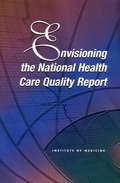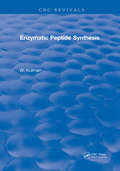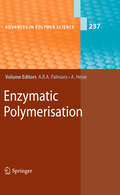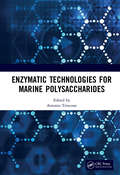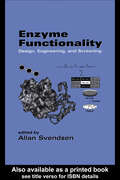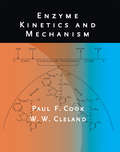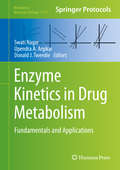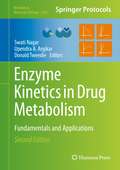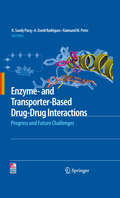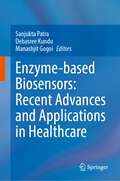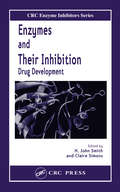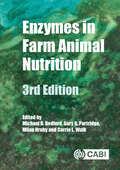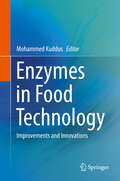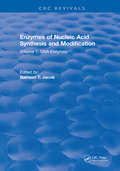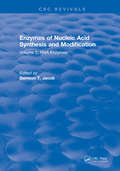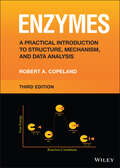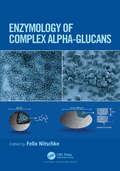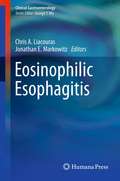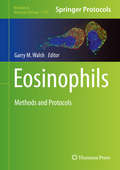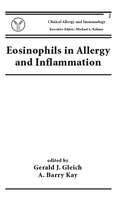- Table View
- List View
Envisioning Embodiment in the Health Humanities: Interdisciplinary Approaches to Literature, Culture, and Media (Sustainable Development Goals Series)
by Nora Martin Peterson Jodi Cressman Lisa DeTora Jeannie LudlowEnvisioning Embodiment in the Health Humanities: Literature, Culture, and Media examines discourses of embodiment across disability studies, gender studies, cultural studies, and visual studies to inform educational practice as well as cultural criticism related to the health and medical humanities. The book argues that imagery and other visual elements in literature, comics, lived experience and the arts demonstrate the hybridity of the embodied experience and identity and have something to offer to clinical practice. Connected to the UN Sustainable Development Goals 3 (Health), 4 (Gender equality), and 16 (Strong institutions), the topics addressed in the essays include mental health, grief, COVID-19, healthcare practices, cancer, and women’s health. The volume is designed to be accessible to advanced undergraduate students as well as graduate students and to be useful for medical practitioners and others who are interested in the health humanities, disability studies, gender studies, or cultural studies.
Envisioning a Transformed Clinical Trials Enterprise in the United States
by Development Anne B. Claiborne Board on Health Sciences Policy Rebecca A. English Neil Weisfeld Rapporteurs Forum on Drug Discovery TranslationThere is growing recognition that the United States' clinical trials enterprise (CTE) faces great challenges. There is a gap between what is desired - where medical care is provided solely based on high quality evidence - and the reality - where there is limited capacity to generate timely and practical evidence for drug development and to support medical treatment decisions. With the need for transforming the CTE in the U. S. becoming more pressing, the IOM Forum on Drug Discovery, Development, and Translation held a two-day workshop in November 2011, bringing together leaders in research and health care. The workshop focused on how to transform the CTE and discussed a vision to make the enterprise more efficient, effective, and fully integrated into the health care system. Key issue areas addressed at the workshop included: the development of a robust clinical trials workforce, the alignment of cultural and financial incentives for clinical trials, and the creation of a sustainable infrastructure to support a transformed CTE. This document summarizes the workshop.
Envisioning the Future of Health Professional Education: Workshop Summary
by Engineering Medicine National Academies of SciencesIn April 2015, the Institute of Medicine convened a public workshop to explore recent shifts in the health and health care industry and their implications for health professional education (HPE) and workforce learning. This study serves as a follow-up to the 2009 Lancet Commission report on health professions education for the 21st century and seeks to expand the report's messages beyond medicine, nursing, and public health. Envisioning the Future of Health Professional Education discusses opportunities for new platforms of communication and learning, continuous education of the health workforce, opportunities for team-based care and other types of collaborations, and social accountability of the health professions. This study explores the implications that shifts in health, policy, and the health care industry could have on HPE and workforce learning, identifies learning platforms that could facilitate effective knowledge transfer with improved quality and efficiency, and discusses opportunities for building a global health workforce that understands the role of culture and health literacy in perceptions and approaches to health and disease.
Envisioning the National Health Care Quality Report
by Institute of MedicineHow good is the quality of health care in the United States? Is quality improving? Or is it suffering? While the average person on the street can follow the state of the economy with economic indicators, we do not have a tool that allows us to track trends in health care quality. Beginning in 2003, the Agency for Healthcare Research and Quality (AHRQ) will produce an annual report on the national trends in the quality of health care delivery in the United States. AHRQ commissioned the Institute of Medicine (IOM) to help develop a vision for this report that will allow national and state policy makers, providers, consumers, and the public at large to track trends in health care quality. Envisioning the National Health Care Quality Reportoffers a framework for health care quality, specific examples of the types of measures that should be included in the report, suggestions on the criteria for selecting measures, as well as advice on reaching the intended audiences. Its recommendations could help the national health care quality report to become a mainstay of our nation's effort to improve health care.
Envy and Gratitude: A study of unconscious sources
by Melanie KleinTavistock Press was established as a co-operative venture between the Tavistock Institute and Routledge & Kegan Paul (RKP) in the 1950s to produce a series of major contributions across the social sciences. This volume is part of a 2001 reissue of a selection of those important works which have since gone out of print, or are difficult to locate. Published by Routledge, 112 volumes in total are being brought together under the name The International Behavioural and Social Sciences Library: Classics from the Tavistock Press. Reproduced here in facsimile, this volume was originally published in 1957 and is available individually. The collection is also available in a number of themed mini-sets of between 5 and 13 volumes, or as a complete collection.
Enzyklopädie der Eponymen Syndrome und Begriffe in Psychiatrie und Klinischer Psychologie: Von Achilles-Komplex über Othello-Syndrom bis Zooanthropie
by Andreas MarnerosEponyme Bezeichnungen haben den großen praktischen Vorteil, dass sie komplexe Begriffe und Konstellationen mit einer einzigen Bezeichnung erfassen. Das bietet Ärztinnen und Ärzten, Psychologinnen und Psychologen als auch Studierenden eine nicht zu unterschätzende Gedächtnishilfe. Zudem steht hinter einem psychiatrischen oder psychologischen Eponym nicht nur ein klinisches Bild oder eine psychopathologische Konstellation, sondern auch ein Mythos, eine Geschichte oder eine Biographie, sprich ein kultureller Hintergrund. Eine Expedition in das Reich der Eponyme bedeutet daher nicht nur die Begegnung mit Wissen, sondern auch eine Berührung mit alter und neuer Kultur. Jeder Begriff wird sowohl in seinem psychiatrisch-psychologischen Kontext als auch in seinem kulturellen Ursprung erläutert. So ergibt sich ein spannendes Gesamtbild aus bekannten und eher unbekannten Eponymen und Syndromen, die alle eine Geschichte erzählen.
Enzymatic Peptide Synthesis
by W. KullmanThis book was first published in 1987. Comprehensive overview of enzyme peptide synthesis.
Enzymatic Polymerisation
by Anja R. Palmans Andreas HeiseOxireductases in the Enzymatic Synthesis of Water-Soluble Conducting Polymers, by E. Ochoteco and D. Mecerreyes * Transferases in Polymer Chemistry, by J. van der Vlist and K. Loos * Hydrolases Part I: Enzyme Mechanism, Selectivity and Control in the Synthesis of Well-Defined Polymers, by M.A.J. Veld and A.R.A. Palmans * Hydrolases in Polymer Chemistry: Chemoenzymatic Approaches to Polymeric Materials, by A. Heise and A.R.A. Palmans * Hydrolases in Polymer Chemistry: Part III: Synthesis and Limited Surface Hydrolysis of Polyesters and Other Polymers, by G.M. Guebitz * Exploiting Biocatalysis in the Synthesis of Supramolecular Polymers, by S. Roy and R. V. Ulijn
Enzymatic Technologies for Marine Polysaccharides
by Antonio TrinconeThe bioactivity potential of marine polysaccharides has long been considered an underexploited aspect. These molecules found in seaweed, microalgae, bacteria, and animal fish (shellfish, mollusks, etc.) and the derived oligosaccharides need to be explored thoroughly with an interdisciplinary approach. They are an extraordinary source of chemical diversity, and the literature highlights many applicative fields, including the food industry, cosmetics, biomedicine, agriculture, environmental protection, wastewater management, etc. More recently, a new challenge has emerged: the exploitation of marine biomass as the source of sustainable energy to participate in the future replacement of fossil resources. Enzymatic Technologies for Marine Polysaccharides provides insight into the recent research developments of marine polysaccharides and their current and potential applications. The first section of the book explores the diversity of marine polysaccharides from various angles, including a description of the chemical complexity and current applications and new perspectives in food, pharmaceutical, cosmetics, and biomaterials offered by recent research. Efficient valorization of the marine polysaccharide biomass requires a rigorous analysis of the polysaccharides structure and their biological properties. The second section of the book concerns the development of extraction techniques and the improvement of the methods aimed at the characterization of their structure and function. Finally, the third and last section of the book articulates the enzymatic technologies from the discovery of novel enzymes to their production pipelines related to the fields of biorefinery, food, pharmaceutics, and other fine chemicals. Presents the latest research in marine oligosaccharides and polysaccharides Written by world-class researchers in marine enzyme technology Discusses the latest developments in extraction methods Presents a detailed overview of enzymatic routes for modification, production, and synthesis of marine oligosaccharides Contains extensive references at the end of each chapter to enhance further study
Enzyme Functionality: Design: Engineering, and Screening
by Allan SvendsenEnzyme Functionality serves as a conduit for trailblazing research in enzyme engineering-relating current understanding of sequence families, the new notion of enzyme structure classes, and modern methods in protein engineering, design, and directed evolution to accelerate the development of novel enzyme functionalities. This reference gathers the
Enzyme Kinetics and Mechanism
by Paul F. Cook W. W. ClelandEnzyme Kinetics and Mechanism is a comprehensive textbook on steady-state enzyme kinetics. Organized according to the experimental process, the text covers kinetic mechanism, relative rates of steps along the reaction pathway, and chemical mechanism—including acid-base chemistry and transition state structure. Practical examples taken from the literature demonstrate theory throughout. The book also features numerous general experimental protocols and how-to explanations for interpreting kinetic data. Written in clear, accessible language, the book will enable graduate students well-versed in biochemistry to understand and describe data at the fundamental level. Enzymologists and molecular biologists will find the text a useful reference.
Enzyme Kinetics in Drug Metabolism
by Swati Nagar Upendra A. Argikar Donald J. TweedieDrug metabolism and transport are very important facets within the discipline of pharmaceutical sciences, with enzyme kinetic concepts utilized regularly in characterizing and modeling the disposition and elimination of drugs. Enzyme Kinetics in Drug Metabolism: Fundamentals and Applications focuses on very practical aspects of applying kinetic principles to drug metabolizing enzymes and transporters. Divided into five convenient sections, topics include the fundamental principles of enzyme kinetics, the kinetics of oxidative and conjugative drug metabolizing enzymes and drug transporters, modeling approaches for both drug metabolizing enzymes and transporters including novel systems biology approaches, understanding of variability both experimental and interindividual (pharmacogenomic), and case studies that provide real life examples of applying these principles. Written in the successful Methods in Molecular Biology series format, chapters include introductions to their respective topics especially suitable for the novice, in some cases step-by-step, readily reproducible protocols, and insights to help with troubleshooting and avoiding known pitfalls with extensive cross referencing to assist in learning. Authoritative and easily accessible, Enzyme Kinetics in Drug Metabolism: Fundamentals and Applications serves as a very practical teaching tool for novice, non-mathematically trained scientists interested in these fundamental concepts and as an aid for their supervisors in teaching these principles.
Enzyme Kinetics in Drug Metabolism: Fundamentals and Applications (Methods in Molecular Biology #2342)
by Swati Nagar Upendra A. Argikar Donald TweedieThis second edition further develops the principles of applying kinetic principles to drug metabolizing enzymes and transporters. Chapters are divided into six sections detailing fundamental principles of enzyme kinetics, enzyme and transporter structures, highlighting specific oxidative and conjugative drug metabolizing enzymes and drug transporters, modeling approaches for drug metabolizing enzymes and transporters, understanding of variability both experimental and interindividual (pharmacogenomic), and expanded case studies that provide real life examples of applying these principles. Written in the highly successful Methods in Molecular Biology series format, chapters include introductions to their respective topics, in some cases step-by-step instructions with readily reproducible laboratory protocols, and tips on troubleshooting and avoiding known pitfalls with extensive cross referencing to assist in learning. Authoritative and fully updated, Enzyme Kinetics in Drug Metabolism: Fundamentals and Applications, Second Edition serves as a practical teaching tool for novice and advanced scientists interested in the fundamental concepts.
Enzyme- and Transporter-Based Drug-Drug Interactions
by A. David Rodrigues Raimund M. Peter K. Sandy PangGermination of the thought of "Enzymatic- and Transporter-Based Drug-Drug Interactions: Progress and Future Challenges" Proceedings came about as part of the annual meeting of The American Association of Pharmaceutical Scientists (AAPS) that was held in San Diego in November of 2007. The attendance of workshop by more than 250 pharmaceutical scientists reflected the increased interest in the area of drug-drug interactions (DDIs), the greater focus of PhRMA, academia, and regulatory agencies, and the rapid pace of growth in knowledge. One of the aims of the workshop was to address the progress made in quantitatively predicting enzyme- and transporter-based DDIs as well as highlighted areas where such predictions are poor or areas that remain challenging for the future. Because of the serious clinical implications, initiatives have arisen from the FDA (http://www.fda.gov/cber/gdlns/interactstud.htm) to highlight the importance of enzyme- and transporter-based DDIs. During the past ten to fifteen years, we have come to realize that transporters, in addition to enzymes, play a vital role in drug elimination. Such insight has been possible because of the continued growth in PK-ADME (pharmacokinetics-absorption-distribution-metabolism-excretion) knowledge, fueled by further advances in molecular biology, greater availability of human tissues, and the development of additional and sophisticated model systems and sensitive assay methods for studying drug metabolism and transport in vitro and in vivo. This has sparked an in-depth probing into mechanisms surrounding DDIs, resulting from ligand-induced changes in nuclear receptors, as well as alterations in transporter and enzyme expression and function. Despite such advances, the in vitro and in vivo study of drug interactions and the integration of various data sets remain challenging. Therefore, it has become apparent that a proceeding that serves to encapsulate current strategies, approaches, methods and applications is necessary. As Editors, we have assembled a number of opinion leaders and asked them to contribute chapters surrounding these issues. Many of these are the original Workshop speakers whereas others had been selected specially to contribute on topics related to basic and applied information that had not been covered in other reference texts on DDI. The resulting tome, entitled Enzyme- and Transporter-Based Drug Interactions: Progress and Future Challenges, comprises of four sections. Twenty-eight chapters covering various topics and perspectives related to the subject of metabolic and transporter-based drug-drug interactions are presented.
Enzyme-based Biosensors: Recent Advances and Applications in Healthcare
by Manashjit Gogoi Sanjukta Patra Debasree KunduThis book summarizes the principles, protocols, and applications of enzyme-based biosensors in healthcare. After providing a brief history and discussing the development of various biosensors used for medical applications, it explores the principles of enzyme-based biosensors and reviews a number of enzyme immobilization techniques. It then addresses the potential of enzyme-based biosensors in the diagnosis of infectious and non-infectious diseases; illustrates the potential of enzyme-based biosensors for non-invasive monitoring of biochemical biomarkers; and assesses the application of paper-based and microfluidic-based nanobiosensors in medical diagnostics. A one-stop resource on recent advances in enzyme-based biosensors in healthcare, this book will appeal to students, researchers and scientists in a range of disciplines, as well as entrepreneurs, and medical/healthcare professionals.
Enzymes and Their Inhibitors: Drug Development
by H. John Smith Claire SimonsFocusing on the development of enzyme inhibitors as therapeutic drugs, Enzymes and Their Inhibitors: Drug Development provides a concise overview of the chemistry of major types of enzymes and their inhibitors. The opening chapters introduce readers to the structure, functions, mechanisms, and kinetics of enzymes, including their use as disease mar
Enzymes in Farm Animal Nutrition
by John Patience Jason Lee Ralf Greiner Kyle Brown Ceinwen Evans Hamish Irving Jari Vehmanperä Kari Juntunen Qingyun Li Amy Petry Aaron Cowieson Daniel Menezes-Blackburn Ursula KonietznyFrom alpha-galactosidases to xylanases, Enzymes in Farm Animal Nutrition provides a comprehensive guide to all aspects associated with enzyme-supplemented animal feeds. It details the history and size of the feed enzyme market, before describing how feed enzymes are manufactured and employed in monogastric, aqua and ruminant diets. This new edition explores considerable advances such as the use of enzymes in fish and shrimp diets, new understanding of how phytases function in the animal, NSPase research and enzymes' extended use in ruminant markets. This book also: - Provides comprehensive coverage of all topics relating to the production, use, co-operativity and analysis of feed enzymes. - Is fully updated throughout, revealing significant developments such as new methods to deliver enzymes (formulations, encapsulations, and liquid spray systems) and advances in enzyme analysis. - Includes brand new chapters on combinations of enzymes, antibiotic-free diets and how to measure response in feed-enzyme trials. Covering biochemistry, enzymology and characteristics relevant to animal feed use, this book forms a valuable resource for academics and students of animal nutrition and production, as well as professionals in the animal feed industry.
Enzymes in Food Technology: Improvements and Innovations
by Mohammed KuddusThe integration of enzymes in food processing is well known, and dedicated research is continually being pursued to address the global food crisis. This book provides a broad, up-to-date overview of the enzymes used in food technology. It discusses microbial, plant and animal enzymes in the context of their applications in the food sector; process of immobilization; thermal and operational stability; increased product specificity and specific activity; enzyme engineering; implementation of high-throughput techniques; screening of relatively unexplored environments; and development of more efficient enzymes. Offering a comprehensive reference resource on the most progressive field of food technology, this book is of interest to professionals, scientists and academics in the food and biotech industries.
Enzymes of Nucleic Acid Synthesis and Modification: Volume 1: DNA Enzymes
by Samson T. JacobThe First volume gives an overview of the enzymes involved in DNA synthesis and modification; the second volume deals with the RNA-enzymes. Although the major emphasis of the book is on eukaryotic enzymes, a separate chapter dealing with prokaryotic DNA repair enzymes has been included to discuss the major advances in this field in recent years. There are two separate chapters on RNA polymerases to provide a comprehensive coverage of the enzymes from lower eukaryotes, plants and higher eukaryotes.
Enzymes of Nucleic Acid Synthesis and Modification: Volume 2: RNA Enzymes
by Samson T. JacobThe First volume gives an overview of the enzymes involved in DNA synthesis and modification; the second volume deals with the RNA-enzymes. Although the major emphasis of the book is on eukaryotic enzymes, a separate chapter dealing with prokaryotic DNA repair enzymes has been included to discuss the major advances in this field in recent years. There are two separate chapters on RNA polymerases to provide a comprehensive coverage of the enzymes from lower eukaryotes, plants and higher eukaryotes.
Enzymes: A Practical Introduction to Structure, Mechanism, and Data Analysis
by Robert A. CopelandENZYMES A complete and approachable introduction to the study of enzymes, from theory to practice Enzymes catalyze the bulk of important biological processes, both metabolic and biochemical. They are specialized proteins whose function is determined by their structure, understanding which is therefore a key focus of biological, pharmacological, and agrarian research, among many others. A thorough knowledge of enzyme structure, pathways, and mechanisms is a fundamental building block of the life sciences and all others connected to them. Enzymes offers a detailed introduction to this critical subject. It analyzes enzyme proteins at the structural level and details the mechanisms by which they perform their catalyzing functions. The book’s in-depth engagement with primary literature and up-to-date research allows it to continuously deploy illustrative examples and connect readers with further research on key subjects. Fully updated after decades as the standard text, this book unlocks a thriving field of biological and biochemical research. Readers of the third edition of Enzymes will also find: Expanded chapters on steady-state and transient-state enzyme kinetics, structural components of enzymes, and more New chapters on enzyme regulation, enzyme-macromolecule interactions, enzyme evolution, and enzymes in human health Key Learning Points at the beginning of each chapter to assist students and instructors Enzymes promises to continue as the standard reference on this subject for practitioners of the life sciences and related fields in both academia and industry.
Enzymology of Complex Alpha-Glucans
by Felix NitschkeGlycogen and Starch: So Similar, yet so Different. Both carbohydrates are central to the primary metabolism of a large part of the living kingdom. Generally, animals, fungi, and bacteria store glycogen, while plants largely rely on starch. This book provides a broad and current view on both glycogen and starch, in lower and higher organisms. Beside biochemistry, physiology and regulation of glycogen and starch metabolism, the reader can expect an insight into glycogen storage diseases, select methods and relevant techniques. While significant progress has been made in both fields, this volume emphasizes an opportunity of collaboration for researchers working on a major intersection of the living world.
Eosinophilic Esophagitis
by Jonathan E. Markowitz Chris A. LiacourasThis volume provides a history of Eosinophilic Esophagitis (EoE), a basic understanding of the physiology of the eosinophil, and a current understanding of the pathophysiology and genetics of EoE. The emphasis is on clinical applications including presenting symptoms, diagnosis and treatment options for patients with EoE. Written by both pediatric and adult experts in the fields of gastroenterology, allergy and pathology, this volume includes the most up to date information. Providing practical information useful in the treatment of patients, this book will be of great value to gastroenterologists, allergists, pathologists, medical residents, fellows, internists, and general practitioners who treat patients with eosinophilic esophagitis.
Eosinophils
by Garry M. WalshThe eosinophil is an enigmatic cell with a continuing ability to fascinate. In this book, experts in the field of eosinophil biology comprehensively update our knowledge on the human eosinophil in health and disease.
Eosinophils in Allergy and Inflammation (Clinical Allergy And Immunology Ser. #2)
by Gerald J. GleichThis work presents the proceedings of a conference held at Adare Manor, County Limerick, Ireland. It provides an updated, in-depth review of the biological role of eosinophils in allergic diseases, summarizing basic knowledge of these unique cationic proteins. The book features an annotated discussion of the conference's post-presentation question-and-answer session.



